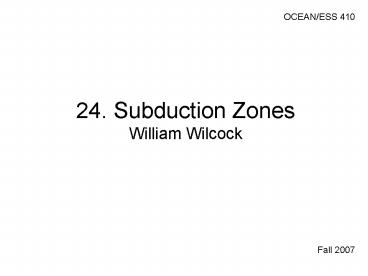24. Subduction Zones William Wilcock - PowerPoint PPT Presentation
1 / 34
Title:
24. Subduction Zones William Wilcock
Description:
Subduction zones are responsible for some of the primary geologic processes on earth: ... Mantle Geotherm and Peridotite Solidus 1 % water ... – PowerPoint PPT presentation
Number of Views:111
Avg rating:3.0/5.0
Title: 24. Subduction Zones William Wilcock
1
24. Subduction ZonesWilliam Wilcock
OCEAN/ESS 410
Fall 2007
2
3 Types of Convergent Margin (Plate Boundary)
3
Subduction Zone Processes
- Subduction zones are important because they are
the downwelling branches in Earths mantle
convection. - Subduction zones are responsible for some of the
primary geologic processes on earth - Convergence leads to the growth of continents by
- volcanism
- accretion of terrains
- Subduction zone processes dominate the
development of active geologic structures on the
continents
4
Subduction Factory
5
(No Transcript)
6
Subduction Factory
7
Mantle Geotherm and Peridotite Solidus
lt1 water
8
Wilson Cycle - Cyclical growth and loss of ocean
basins leads to continental growth
9
(No Transcript)
10
(No Transcript)
11
Passive Margin
12
(No Transcript)
13
(No Transcript)
14
Convergent (Active) Margin
15
(No Transcript)
16
Stable Continent Bigger than Stage A
17
Forces acting on a subducting slab
The plate sinks under gravity (red arrow)
according to its weight, thus how cold and dense
it is. The slab also drags along adjacent mantle
(black arrows). This mantle is pushed up against
the subducting slab on the left hand side
generating a high pressure region. The mantle is
dragged down with the slab on the right hand side
generating a low pressure. This pressure
differential tends to lift the slab.
Velocity
Age
Velocity
18
Balance of Gravitational and Pressure Forces
Influences Slab Dip
- Old (Cold) Plate Slow Subduction
- Large gravitational force, small pressure force.
Steep subduction angle - Young (Warm) Plate Fast Subduction
- Small gravitational force, large pressure force.
Shallow subduction angle
19
(No Transcript)
20
Subduction Rate, cm/yr
Plate Age
21
(No Transcript)
22
Island Arcs - Back Arc Spreading
23
Back-Arc Spreading
- Two Ideas
- Subducting slab falls away
- Mantle flow in wedge creates extension
24
Thermal Structure
25
Deep Forces Resulting From Phase Changes
Enhances Subduction
- Opposes Subduction
26
Many Slabs to not penetrate 670 km discontinuity
27
Subduction Zone Earthquakes
28
Earthquakes
- Shallow Earthquakes
- Plate Boundary - Megathrust
- Surrounding Plates
- Deep Earthquakes
- Mineral phase changes as pressure increases and
loss of water bearing minerals - incompletely
understood
29
Cascadia Locked Zone
30
Cascadia Subduction ZoneLast earthquake 1700.
Recurrence interval 200-1000 years (average
500 years)
31
- Block diagram/cross section of tectonics
32
Cascadia
Warm slab implies dewatering at shallow depths
and weak arc volcanism
33
Deformation in Subduction Zones
Accretionary Prism forms when sediments are
present and scraped off subducting slab
34
Oblique Subduction Leads to Shearing
- This shearing also affects the forearc causing
rotation of the strong Oregon block. - Compression of Puget Sound































